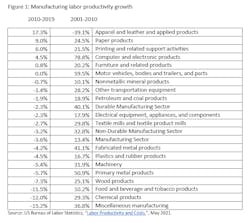US Manufacturing Productivity Is Falling, and It's Cause for Alarm
The U.S. economy has been in a productivity depression for more than a decade, suffering from a historically unprecedented slowdown in labor productivity growth. The issue is finally getting attention, at least among some scholars and think tanks.
One widely offered explanation for the slowdown is the shift to services, which has historically seen slower productivity growth than manufacturing. The OECD writes, “the shift to services entails a moderate but persistent drag on productivity growth.” This and other similar claims build off of William Baumol’s work that asserted that as productivity grows in manufacturing, jobs and activity will shift to less productive services, slowing overall productivity growth.
This argument seems to make sense. Only one problem: U.S. manufacturing productivity is also in crisis.
According to the Bureau of Labor Statistics (BLS), from 2010 to 2019, labor productivity growth in U.S. manufacturing fell. It was the first time since the BLS started measuring this in 1988 and likely the first time in American history. Not only did manufacturing productivity not grow over 10 years, but it actually declined. This means that more workers were needed to produce the same amount of output. The result is higher prices, lower wage growth, and less U.S. global manufacturing competitiveness.
This decline was across most industries. Out of 19 major sectors, only five saw increased productivity. And for all but apparel and leather products, the increases were minimal. The other 14 sectors saw declines in labor productivity; for example, primary metal products were 6% less productive and chemical products 12 percent less productive. (See Figure 1.)
Compare that to the 10-year period from 2001 to 2010 when manufacturing productivity grew 41%. Even accounting for the fact that output and productivity were likely overstated in this period for the computer and electronics sector, there was still higher productivity growth in nearly every other sector.
Figure 1: Manufacturing labor productivity growth
Some will claim measurement error. This seems dubious given there was very little difference in what was produced in the 2000s and the 2010s, and BLS methodologies did not significantly change. Even if there is some mismeasurement, it cannot account for the fact that overall manufacturing productivity growth fell from 41% growth in the 2000s to a 4% decline in the 2010s.
Perhaps it is compositional, with industries exposed to China trade increasing productivity less because of cost pressures. But in fact, many sectors that are largely domestic in sales saw steep declines, such as sign manufacturing (-11%), cement and concrete (-20%), bread and bakeries (-22%).
What about new technologies we keep hearing about, framed in terms as “Industry 4.0” and the “Second Machine Age”? Leaving aside that the best way to sell books and give Ted Talks is to exaggerate the pace of technological change, the reality is that these technologies are still in the early part of the “S” curve. They are often costly, with limited performance. This is one reason why few companies are adopting them. As ITIF found in a 2019 survey of over 100 mid-sized U.S. manufacturing companies, just 5% of the companies have mapped where AI opportunities exist and developed a clear strategy for sourcing the data that AI requires. And 56% of companies had no plans to do so.
These are mostly companies with sales north of $500 million. The adoption rates for smaller manufacturers are surely much lower. This is not to say that these technologies will not get cheaper and better. Surely, they will. But they don’t appear to make a big dent in productivity now.
Another factor might be wages. With the failure to raise the minimum wage and the significant increase in low-skill immigration, many manufacturers can staff operations with a relatively low-paid workforce. This reduces their incentive to invest in raising productivity. There is a strong positive correlation (0.48) between the growth in labor productivity and total employee compensation over this period for manufacturers. Indeed, higher productivity enables firms to pay higher wages. Still, it’s also likely that the causation runs the other direction, with lower wages providing less motivation for raising productivity. This is one reason why the United States lags behind many other nations in adopting industrial robots. In 2017, the United States lagged behind Korea, Singapore, Germany, Japan, Sweden, and Denmark in robot adoption per manufacturing worker. When wages were controlled for the United States, it had 50% fewer robots than it should have.
Another reason, perhaps the main one, is likely that much of the “low-hanging” fruit in manufacturing was already “picked” in prior decades. It is now a lot harder to seek out efficiency gains, given how efficient many factories already are.
But that doesn’t mean we should give up, and it certainly doesn’t explain negative productivity growth.
So what should the government do to change this dismal course?
First, they should raise the incentives for investing in productivity. This means making it harder to go the low-road way by raising the minimum wage and limiting low-skill immigration. It also means not letting expire the current provision in the federal tax code allowing companies to expense in the first year expenditures on capital goods. But Congress should go further. It should reinstitute the investment tax credit that was mistakenly eliminated in the 1986 tax reform act under the misguided notion that tax policy should not distort investment decisions. They ended the “distortions,” and investment declined.
Second, Washington should stop talking and start doing when it comes to policies to upskill U.S. manufacturing workers, whether through support for apprenticeship programs, skills standards programs, regional industry-led skills alliances or support for industry-focused community and technical colleges.
Third, Congress should establish a program to fund labor-company productivity partnerships. Organized labor is often unfairly painted as being against technology. In fact, that is usually not the case. What labor wants is to ensure that they have some say in how technology is implemented and that they will share in at least some of the gains. Supporting formal joint union-company/industry productivity partnerships can align incentives and foster progress.
Finally, the federal government should massively increase funding for manufacturing programs. Some of our competitors invest up to 40 times more on a per-GDP basis in programs like manufacturing extension services and industry-university research cooperative programs. The recently passed Senate U.S. Innovation and Competition Act tries to rectify at least some of this shortfall. As this bill goes to conference with the House, it is critical to keep these manufacturing provisions, including creating a national Manufacturing Council, in any final legislation going to President Biden’s desk.
More than 230 years ago, Alexander Hamilton warned against the new republic as a nation of hewers of wood and drawers of water. Thankfully, he was listened to, and the United States became the world’s greatest manufacturing economy. Today we need to renew “Hamiltoniansm” to revive U.S. manufacturing. This has to start with putting robust productivity growth at the center of the agenda.
Robert D. Atkinson is the founder and president of the Information Technology and Innovation Foundation (ITIF), a think tank for science and technology policy.

